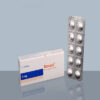Description:
Indications of Rovast 10
Rosuvastatin is indicated for High cholesterol. Rovast 10 is a member of the statin drug class. It lowers cholesterol and lowers the chance of developing heart disease. A fatty substance called cholesterol causes your blood vessels to narrow as it accumulates, which can result in a heart attack or stroke. Rovast 10 is a medication that is frequently administered and is thought to be secure for long-term use.
Pharmacology
Rosuvastatin is a selective and competitive inhibitor of HMGCoA reductase. HMGCoA reductase is the limit for the conversion of 3-hydroxy-3-methylglutaryl-CoA to mevalonate (a cholesterol precursor). Speed ??enzyme. Rosuvastatin produces its lipid modification effect in two ways. First, it increases the number of liver low-density lipoprotein receptors on the cell surface to enhance the absorption and catabolism of low-density lipoprotein. Secondly, Rosuvastatin inhibits liver VLDL synthesis and reduces the total number of VLDL and LDL particles.
Dosage & Administration
- Dose range: 5-40 mg once daily. Use 40 mg dose only for patients not reaching LDL-C goal with 20 mg
- HoFH: Starting dose 20 mg/day.
- Pediatric patients with HeFH: 5-10 mg/day for patients 8 to less than 10 years age, and 5-20 mg/day for patients 10 to 17 years of age.
- Pediatric patients with HoFH: 20 mg/day for patients 7 to 17 years of age.
Interactions of Rovast 10
Remarkable drug interactions of Rosuvastatin are-
Cyclosporine: Combination increases Rosuvastatin exposure. Rosuvastatin dose should be limited to 5 mg once daily.
Gemfibrosil: Combination should be avoided. If used together, Rosuvastatin dose should be limited to 10 mg once daily.
Lopinavir/Ritonavir or atazanavir/ritonavir: Combination increases Rosuvastatin exposure. Rosuvastatin dose should be to 10 mg once daily.
Coumarin anticoagulants: Combination prolongs international normalized ratio (INR). Stable INR should be achieved prior to starting Rosuvastatin. INR should be monitored frequently until stable upon initiation or alteration of Rosuvastatin therapy.
Concomitant lipid-lowering therapies: Use with fibrates and niacin products may increase the risk of skeletal muscle effects.
Contraindications
Rosuvastatin is contraindicated if-
Known hypersensitivity to product components
Liver disease, which may include unexplained persistent elevations in hepatic transaminase levels
Pregnant women and women who may become pregnant
Nursing mothers
Side Effects of Rovast 10
In general, rosuvastatin is well tolerated. The most common adverse events thought to be related to rosuvastatin are headache, myalgia, constipation, weakness, abdominal pain, and nausea.
Pregnancy
The safety of pregnant women has not been determined. It is unknown whether rosuvastatin is excreted in human milk.
Precautions
Effects on skeletal muscle (eg, myopathy and rhabdomyolysis): risk varies with 40 mg dose, advanced age (> 65 years), hypothyroidism, renal impairment, and interaction with cyclosporine, lopinavir / ritone Weir, atazanavir / ritonavir, or some other Lipid-lowering drugs are used in combination. Patients should be advised to report unexplained muscle pain, tenderness, or weakness early. If signs or symptoms appear, rosuvastatin can be stopped. Abnormal liver enzymes and monitoring: Continuous elevation of liver transaminases may occur.
Liver enzymes should be monitored before and during treatment.
Therapeutic Class
Other Anti-anginal & Anti-ischaemic drugs, Statins
Storage Conditions
Keep below 30oC temperature, protected from light & moisture. Keep out of the reach of children.







Reviews
There are no reviews yet.